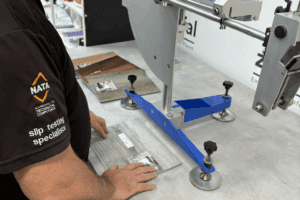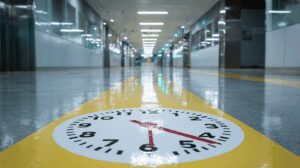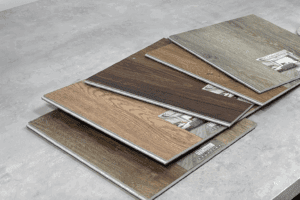How Much Does Slip Resistance Lab Testing Cost?
Why Transparent Pricing Matters
For builders, architects, and product suppliers, knowing the cost of slip resistance testing upfront helps with budgeting and compliance planning. Zerofal’s pricing is structured to be predictable, with clear fees based on the number of samples and the test methods required. All testing is carried out in our Sydney laboratory under AS 4586:2013, using a calibrated pendulum(wet) and TORTUS 3 (dry friction) equipment.
Indicative Lab Testing Costs
Typical costs for in-lab testing are:
- Initial setup fee per job – $0 (covers logging, inspection, and preparation of samples).
- Wet pendulum test (P0–P5 classification) – $200 + GST per classification.
- Dry floor friction test (D0/D1 classification) – $200 + GST per sample.
- Combined wet + dry tests – $380 + GST per sample (discounted when both methods are run together).
- Bulk testing rates – for 6 or more samples in the same submission, wet pendulum testing drops to $175 + GST per sample, with proportional reductions for dry or combined tests.
- Report issuance – included in all fees; NATA-traceable certificates are standard.
Courier labels are available nationally to simplify logistics; freight charges vary by location, size and weight.
What Influences the Final Price?
- Test Method
Wet pendulum is the most common, but dry testing may be required where surfaces are always dry. Combined tests are often the most cost-effective option. - Sample Volume
Testing a single sample attracts the full rate. Submitting multiple finishes, colours, or textures together reduces the per-sample fee. - Logistics
Courier costs depend on where the samples are coming from, size and weight, but Zerofal’s national labels simplify this step. - Turnaround Time
Standard turnaround is within 3-5 business days. Urgent testing can be arranged at an additional charge.
Why Lab Testing Is Cost-Effective
Slip resistance testing is a small investment compared to the cost of non-compliance:
- A slip injury claim can easily exceed $30,000–$50,000.
- Non-compliant tiles can cause delays in occupancy certificates or handover.
- Testing product lines in bulk reduces long-term costs and ensures all finishes are covered.
It’s far cheaper to test before installation than to manage the consequences after a slip.
What About In-Situ Testing?
Zerofal also carries out AS 4663:2013 in-situ testing for existing surfaces. Unlike lab work, these costs are influenced heavily by location, access, and number of test points, so pricing is provided on request.
Contact us to discuss your site and we’ll prepare a tailored quote.
Book a Lab Test Today
Make sure your surfaces are compliant before they’re installed. Contact Zerofal for fast, certifiable slip resistance testing.
Explore more

How Much Does Slip Resistance Lab Testing Cost?
Slip resistance testing costs depend on surface type, number of samples, and method (wet pendulum or dry friction). This guide explains typical AS 4586 lab pricing, what’s included in a

Cure Time Matters—Avoid Testing Too Soon
Curing is one of the most overlooked factors in slip resistance testing. This article explains how premature testing can understate performance, invalidate AS 4586 results, and cost clients compliance. Learn

Is Your Sample Ready? Prep Checklist
Accurate slip resistance results start before the test begins. This guide outlines how to prepare your samples for AS 4586 testing – covering size, cleaning, curing, and packaging – to
